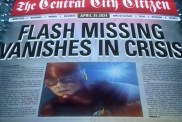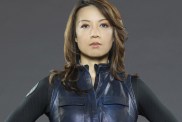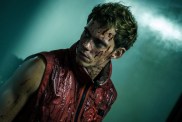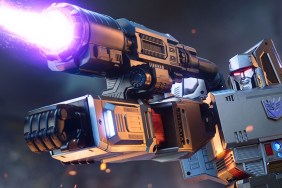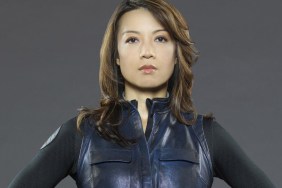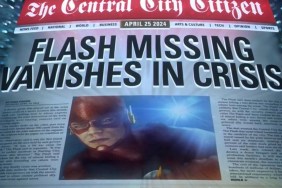
Executive Producer Chris Lee has a couple of notable films on his filmography including “S.W.A.T.” and “Final Fantasy: The Spirits Within.” But without a doubt Superman Returns is his biggest film to date. Chris spoke to a gaggle of online press last year while filming on location at the Sydney Museum:
Chris Lee: Thanks for coming all the way. We’re almost at day 100… Feel a little tired but it’s looking really good. We’re very happy obviously with the response at Comic Con and everything…. so… it’s good! We’re glad!
Q: Is that what’s really driving you… getting the response at Comic Con, and also with the Internet reactions?
Lee: You guys know your fan base better than anybody and it is interesting because there’s that specific opinion about everything that we do, so when you have the opportunity to have Bryan cut a reel and go to Comic Con and get that very visceral immediate response from the people that really matter the most in this kind of movie… It’s a good chance to sort of sit back and take stock at what we’ve been doing since last November really and from the 1st of January when we got here. It can go both ways for you. It usually goes one way for Bryan, so we’re happy to be consistent with that and it was definitively worth 35 hours in the air.
Q: How have you found working with Bryan?
Lee: I’ve known Bryan socially and professionally for about 10-12 years and I’m largely here because of him, because both he and the studio wanted somebody on the ground that he was comfortable with and I’m very honored to be a part of this team. Of course I’ve known Mike (Dougherty) and Dan (Harris) a long time. Part of the genesis of this production was actually when they were all visiting me in Hawaii last July 4th so it’s great and I think you know, you never know, but I think it’s going to be his best film yet.
Q: Is it important to have a very close unit in this production? In Bryan’s films there’s always a close family.
Lee: Generally, yeah, probably on a professional basis although we did have people together. I was an executive at Tri-Star back then. I think Guy [Dyas] has done five movies. Of course Mike and Dan wrote the X-Men 2 picture, and so Bryan likes having a family around him of people that he’s worked with before and trusts, and there’s a short hand that goes with that.
Q: Bryan and you and his people were kind of grafted on to a production that has already been moving forward and then kind of fell apart… and some of those people are still here…
Lee: I know that the concept of shooting in Australia was rolling forward and last year when they were all visiting me in Hawaii on the July 4th weekend, I guess that’s about when it didn’t work out with McG… I don’t know the extent to which the crew here was all set… I know Guy was new… so that was all new… I’ve never read the script from the McG movie so I understand it’s very different. I’ve seen some of the animatics which seems very different to me than in the movie that we’re making. So whatever designs there were, I know this was a big issue for Warner Bros. and for Bryan was “Are you willing to go with the vision that we have for it” and whatever it is that Mike (Dougherty), Dan (Harris) and Bryan wrote on the plane on the way back from Hawaii that’s sort of the one they pitched to Alan (Horn) and they can tell you all these stories. I know it’s a very, very different movie from what was being planned at that time. As a former executive I can tell you that it’s extraordinary for me that a movie of this size and scope moved so quickly even though there was a whole 10 years of history of trying to get this movie off the ground. To go from what was essentially a pitch in July to production in March to day 100 almost right now is pretty extraordinary and I think it’s testament to that relationship you were just talking about, the short hand that Bryan has with his production designer, with his DP with his writing team and that’s one of the reasons they were able to accomplish that so quickly. And on top of that the crews here in Australia from construction all the way through catering are just fantastic. And even though we’re on 8 stages… even though there are only 7 stages at Fox… Did you see the glass bottom boat? That’s normally a construction zone. And when we shot there, and every time a plane would go over we’d have to stop because it’s not sound proof. We really pushed the limits and every time we finish one big set we’d have to take it down. I wish you could have seen the Daily Planet, I wish you could have seen the Fortress of Solitude in the arctic set, they were just so spectacular but we had to move on and get to the next big massive set. So all of that again is a testament to both the crews here and sort of the cohesive vision that Bryan’s team has in terms of how you get a movie like this mounted so quickly.
Q: With pulling down the sets and things so quickly, does that cause a problem in having to pick up something later on?
Lee: Well, I think ideally you’d love to keep your sets up. It’s not really possible. But I’m the one who tends to get the calls from the construction crew saying “Are we done?” and then I talk to the editorial, John Ottman and Elliot Graham, they are so much a part of Bryan’s history, the editorial crew. And they’re the ones who sort of like with Bryan say, “Yeah, Ok, we can move on”. Some of the key pieces of sets…and actually the Daily Planet is what we call “fold and hold” We took it all apart and it’s all boxed up nicely in containers and hopefully if we get to make more movies it will be available to us. But by and large it’s optimal but it’s just not realistic unfortunately. We’re really pushing the limits of the stage space as it is.
Q: How much more time do you have left?
Lee: I think we’re supposed to wrap some time in the first or second week of September. We’ve got a bunch of water scenes, and water scenes tend to scare everybody… they’re in tanks though at least. So we’ll see how it goes. They tend to slow you down, but we’re basically totally on schedule right now and maybe one day over at the most but we’ve actually picked up some time since Kevin [Spacey] got here so we’re pretty proud of being so much on schedule again, given the size of this picture.
Q: Is Kevin’s schedule in regards to getting back to the Old Vic theatre (in London) an issue?
Lee: It’s not an issue now but it was an issue as we scheduled the movie because we had six weeks with him, and Bryan would prefer to shoot in continuity and we didn’t have that luxury, but we kind of were in that issue originally with Hugh Laurie because he was going to be Perry White and then the TV show (House) came up and we were moving his things around and we couldn’t make that work. But we’ve made it work (for Kevin Spacey). And it’s kind of fun actually because he’s come in and Parker Posey and Kal Penn and Dave Fabrizio and then we’ve got Ian Roberts and Vince Stone from here, it’s kind of a whole other movie suddenly is taking place and that gives you a kind of renewed energy and everything. It’s different. It’s challenging… the first day they were shooting they were mid movie and they were mid scene, and he’d just gotten off the plane and everything. And he was a total trooper about it. It will be close but we’ll get it done. I don’t know if you’ve got a chance to meet with him yet but I think he’ll be the definitive Lex.
Q: Looking at the Batman movie in 1989, the original Superman, and the first Spider-Man, they were cultural phenomenon. Is that something you guys are keeping in the back of your mind to gauge the success of this movie? Does it have to ignite passion within people and be this huge phenomenon for it to be a true success? Or could be it be more like “Batman Begins” and get great reviews to start with?
Lee: Well, you know the franchises are a little different because the last Batman movie wasn’t that long ago. There’s a couple of differences in approach in terms of… as I understand it Chris Nolan wanted to say like none of those other movies ever existed and when he said “Batman Begins” he meant it. In this case, Bryan talks about the vague history and the utilization of all the mythology that’s come before but in particular the 1978 Donner film. So I think the challenge for us is we are almost 30 years from the 1978 film and contemporary audiences have a sense of Superman more from the television shows than they do from feature film… by contemporary I mean everybody under 25, and I guess people over 25 certainly know and remember the ’78 film very well and remember Chris Reeve very well. And I think the challenge for Bryan is living up to that legacy, honoring it, but improving it for today’s audiences as well. I’ll let Brian speak to how to he wants to define success or not. I certainly, again, feel very privileged to be on this picture and the way it’s turning out and everything. It’s certainly fulfilling whatever my personal goals and standards for how you define success on a picture.
Q: Warner Bros have stated that this movie will be dedicated to Christopher Reeve. Was it something that you had in mind before they forced it upon you?
Lee: No, they didn’t force it… I think it’s a pretty obvious thing that’s been in discussion… I think there was a comment, I believe, from Alan Horn, who is the chairman, and it was something he’d discussed extensively with Bryan. So certainly it’s appropriate. If you remember the ’78 film actually starts with a dedication to Geoffrey Unsworth who was the director of photography. So it certainly would be in keeping again with what happened in the ’78 film.
Q: Have you always been a Superman fan?
Lee: I didn’t have many Superman comics growing up. I probably had more Batman comics. But when I first came on board I ran down to the local comic book store. I lived in Hawaii and I bought about 400 hundred dollars worth of the archive books. I just wanted to look at it at every decade. The salesperson asked me if I was doing a thesis. I said, “Yes, something like that.” (laughs) I was surprised by his evolution as a character and if you go back to those early ones his behavior and things that we associate with him were not a part of the mythology at all. In fact there’s a sort of a running thing where he wears a lot of disguises and he takes over people’s lives like he kidnaps them, and then he ties them up and he litrally drugs them then ties them up or something and then he goes and participates in their lives and he gets involved in footfall, fixing scandals, there’s a lot of things with munitions makers. He was sort of politically oriented, it seemed like. But there was no flying, there was a little bit of jumping… So, I think that it’s pretty remarkable to watch his evolution and I guess when you approach a Superman movie you have a lot of choices to make, you have a lot of mythology that you can pick from and I think that what we think of this as the common history of the ’78 film… I think they did a great job at synthesizing a lot of that.
Q: Are there any stories or images of Superman from the comics that define the approach of this movie?
Lee: It’s not my approach, it’s Bryan’s approach. (laughs) That’s really more of a question for Bryan, not for me. We’re just here to facilitate his vision, but I think I certainly personally agree thematically with the way that they’ve gone with the picture. I think that if you look at everything Bryan does and everything that Mike and Dan do, their movies are always about something, and I think when they talk about how the world treats the return of saviors and how we as individuals treat the return of old boyfriends. I think that on a micro and macro level, its something that everybody can relate to. So, I actually looked at all four of the films also when I was doing my little research, and I grew up on the television show, so I was very excited to meet Noel Neill and Jack Larson who did important little roles in our picture. I think that it’s important today that Superman be perceived as a global hero, I think that’s very key and I think that it’s one of the issues that they’ve addressed appropriately in the material.
Q: You say Global Hero, but Superman is such an American Icon. But now America is viewed differently in the world, especially in the last 5 years or so, as bit more of an antagonist… How’s that going to affect the way you portray the character?
Lee: I think we’re all cognizant of that. I think that Bryan is better at speaking to that on a creative level. But I think we would be doing a disservice to the character and to the franchise if we didn’t recognize that the world has changed and in some ways the whole notion of Superman’s gone for five years and he’s come back and the world has moved on…. He is basically this amazing embodiment of America in some way. Bryan has spoken about how he is the ultimate immigrant. He comes to the country, he comes to the planet with all his skills and he tries to apply them to the betterment of society in general. That’s a global story in itself, and I think that the threats that occur in the picture are on a global basis, they’re not just, you know, it’s going to be an issue for Metropolis or an issue for America, per se. But you’ll see when you see the picture.
Q: How do you feel about the comic book movie genre? Do you feel like it’s getting better?
Lee: What’s fascinating about it is as a canvas for directors like Bryan or Chris Nolan, I think that Sam Raimi was always a true believer to begin with. He just came out of that tradition. His movies were comic books from the beginning. But I think for someone like Bryan who wasn’t into comic books (I don’t know anything about Chris Nolan), you see the opportunity to take sort of extraordinary situations but apply very human emotions to them and make it relatable. I personally think that there’s going to be no shortage of these comic book movies and as with all films, it’s really the filmmaker that’s going to make the difference to its success, on many different levels. And I think you’re always better off if you have an accomplished director with a strong sense of story, strong sense of emotional resonance for the audience than you have with someone who is just better at cutting or shooting… Because comic books, people relate to them on a very emotional levels, they respond to them because they speak to them. And when you have a movie that’s just flash, they’re very forgettable as with most films. So, I think the same rules apply as apply to any approach to a picture.
Q: Bryan’s renowned for being very prepared. Is it your job just to give him options?
Lee: I think all of us try to give him options, and one of the things that Guy Dyas always says is, “I always give Bryan more than less”. For instance like on this set today, there were a number of choices in terms of set design, Bryan could approach a scene and he chose one and we understand that. Bryan always knows exactly what he wants and everything has a precision to it and that’s reflected in his work. But I think you do get a sense, working with him, of knowing what’s he’s going to sort of go for and go away from. That’s part of the short-hand again on whether Tom or John or Mike or Dan or Guy, in terms of working with him, is just having a bit of a sixth sense about whether Bryan’s going to like this. But at the end of day he surprises us all the time.
Q: Are you doing any location shooting outside Australia?
Lee: We did some plate work at Dodger Stadium. More than plate work, actually. We had fans and stuff like that. I think I saw something about some plate work in New York, but I’m not sure. But pretty much everything is done here. The largest exterior obviously was the Kent Farm in Tamworth which just looks extraordinary. And beside this little issue of mountains in Kansas, which seems to broil through the websites a lot, I think everybody will really like it a lot. It’s really true that Tamworth has apparently the number 2 rated sunsets in the world. We did a blog about this. The sky was just amazing there they capture them in all their glory with the wonderful Genesis camera. So yeah, but pretty much everything is done here (in Australia).
Q : How do you feel about the casting of Brandon. Was it important getting an unknown?
Lee: I think it was probably the most crucial decision for Bryan – finding the right Superman/Clark Kent – and I know that he and Roger Mussenden, the casting director, looked at about a 1000 different guys for the part and I was around for the screen test for the finalists and I think that you couldn’t imagine anybody better… When you meet him you’re just physically overwhelmed by this resemblance and the smile and everything. But it’s the performance that totally wins you over. His Clark is so sly. There’s really three different characters, there’s Clark Kent on the farm, Clark Kent at the Daily Planet who’s this bumbling Clark Kent, and then there’s Superman. I remember the first time we filmed on the roof top and he said something to Miss Lane and I was like “Oh my God! It’s like him!”. So it’s great… We’re very fortunate and I think the world will really, really, enjoy his performance.
Q: It’s such a huge leap for him. Was there any concern initially? Do you think he’s really stepped up?
Lee: I don’t think people should really equate unknown with untalented. I think one of the things Bryan is noted for is his casting ability. I think we had a lot of really interesting choices and also in the way performances worked out. I love what Frank Langella did with Perry White. A tremendous quiet authority. I mean he’s not doing Jonah Jameson. He’s not doing Jackie Cooper.
Q: It’s like with Hugh Jackman. He struck gold. Do you think he did the same thing with Brandon?
Lee: If we haven’t then we don’t have a picture (laughs). So I certainly think so, yeah. Absolutely.
Read Part 8 of our visit, an interview with costume supervisor Dan Bronson and costume designer Louise Mingenbach.
Superman Returns opens in conventional theaters, IMAX and IMAX 3D on June 30.
Source: Scott Chitwood

